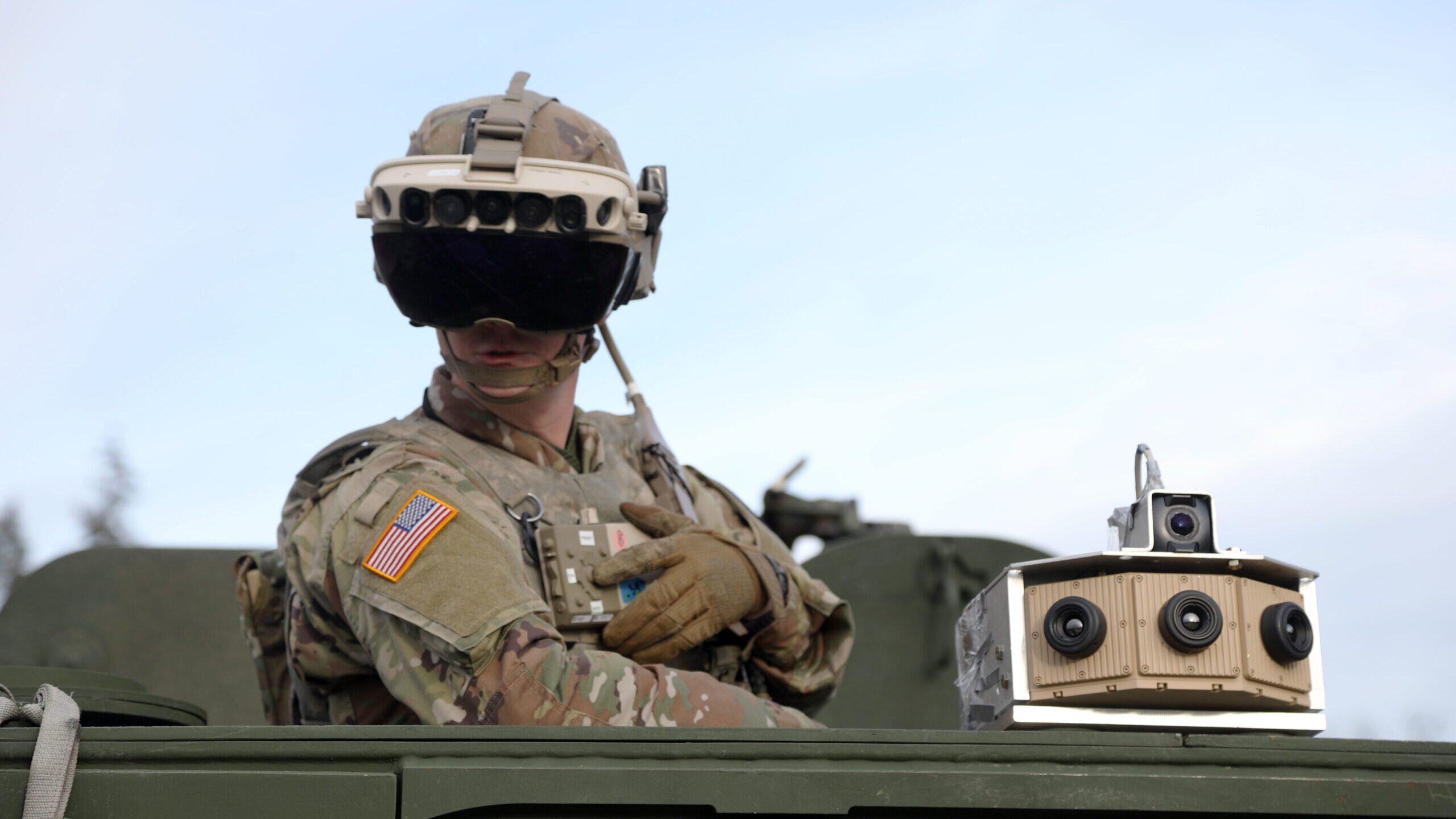
Soldier dons the Integrated Visual Augmentation System Capability Set 3 hardware while mounted on a Stryker in Joint Base Lewis-McCord, WA. (Courtney Bacon/US Army)
WASHINGTON: Congress is withholding $349 million in procurement funding for the beleaguered Integrated Visual Augmentation System in its fiscal 2022 defense package, but provided a whopping $374 million increase for counter-small drone procurement.
Lawmakers announced earlier this week a $782 billion national defense spending package for FY22 nearly six months after the fiscal year started. While the Army received substantial increases to both its procurement and research and development accounts, lawmakers chopped $393.7 million in procurement funding off the IVAS program — essentially battlefield augmented reality headsets — labeling it “ahead of need.”
“We are working through that,” Doug Bush, assistant secretary of the Army for acquisition, logistics and technology, said Wednesday when asked by reporters about the impact of the cuts on IVAS.
The IVAS program’s operational test was moved the last quarter of FY21 to May after the goggles experienced numerous issues in the field. In response, appropriators put $349 million “on hold,” according to the explanatory statement, until IVAS completes its initial operational test and Program Executive Office Soldier briefs the appropriations committees. The agreement leaves in place $405 million in procurement “to maintain contractual production requirements.” The bill also moved $55 million from procurement to R&D for the program.
But while the IVAS may have seen a cut, other programs saw a boon. The Army received a $1.5 billion increase above its budget request for its overall procurement funds, totaling $22.8 billion, including cash for some major initiatives.
Included in that procurement is an eye-popping $374 million budget increase over its FY22 budget request of $60 million for counter-Small Unmanned Aerial System (c-UAS), bringing its total to $434 million. The Army has become increasingly concerned about drones in recent months, with Army Chief of Staff James McConville frequently referring to drones as the new improvised explosive device (IED). On Tuesday, he specifically pointed to the success that the Ukrainian-operated, Turkish-made TB2 Bayraktar drones were having against Russia despite their formidable air defenses.
Tom Spoehr, director of the Heritage Foundation’s Center of National Defense, said the amount of money the Army allocated to c-UAS is “extraordinary.”
“That’s much more than just like a program plus up. That’s an extraordinary amount of money. I think that’s a recognition of the role of the drone … in modern warfare,” Spoehr said, also citing the TB2’s success in Ukraine and the Nagorno-Karabakh. “This problem has got everyone’s attention.”
Also in procurement, Congress significantly boosted procurement for weapons and tracked combat vehicles portfolio, increasing its budget to $4.3 billion, about $443 million above the service’s budget request. The defense bill gives the Army a $175 million above the request, about $1.15 billion total, to upgrade 90 M1A2 SEPv3 Abrams tanks, according to a congressional summary of the legislation.
The legislation also includes $139 million above the budget request to buy 41 more Stryker combat vehicles, bringing the total budget for Strykers to $1.08 billion for 228 vehicles. The defense spending bill also fully funds the service’s Joint Light Tactical Vehicle program, putting $574.6 million into the Army’s coffers for 2,744 trucks and trailers. Oshkosh Defense currently manufacturers the JLTV for the Army and Marines Corps, but the Army is re-competing that contract this year.
The Army’s new Cold Weather All-Terrain Vehicle was fully funded at $16.5 million. Oshkosh and BAE Systems both built prototypes for the CATV program that passed grueling testing in the Alaska last year and competing for the production contract. The service plans to buy 10 CATVs in FY22, eventually buying 163 by FY32.
The service’s RDT&E budget overall saw a $1.6 billion increase over the original request, with the Army’s six priority modernization areas receiving tens of millions of dollars more than their requests ask.
Congress added $77.5 million to the service’s budget for its Future Long Range Assault Aircraft, bringing its total to $521 million. While lawmakers are adding money to the FLRAA program, Army Secretary Christine Wormuth signaled earlier this week that programs such as FLRAA will soon be needing more money, even if the FY23 budget will have “continuity” for modernization platforms.
“After a few years of initial work on FVL [future vertical lift] and ground vehicles, we’re reaching a point where obviously getting out into the mid- and far-years, the investments required are going to be very significant,” she said Wednesday.
The future vertical lift RDT&E portfolio received $42 million bump over the budget request, bringing its total to $133.4 million. That includes a $15 million program increase for a high density power source for electric vertical take off and landing platforms (eVTOL).
The Air and Missile Defense research line received $93.6 million, up from $19.3 million in its budget request. That includes $26 million in program increased for high energy laser technology, testing and integration. It also received a $12.5 million increase for beam control systems and optical fiber fabrication for directed energy weapons.
Long-Range Precision Fires, the Army’s top modernization priority, fared well under the omnibus bill. Lawmakers provided $286 million for the service’s Mid-Range Capability and $188 million for its Precision Strike Missile, fully funding both of those programs. The service also received $315 million for its Long Range Hypersonic Weapon, $15 million more than the ask.
Move over FARA: General Atomics pitching new Gray Eagle version for armed scout mission
General Atomics will also showcase its Mojave demonstrator for the first time during the Army Aviation Association of America conference in Denver, a company spokesman said.


























